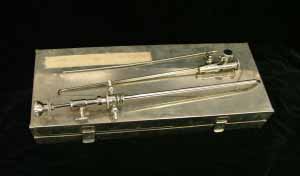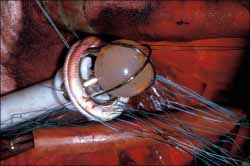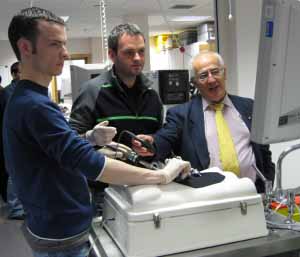Innovation in the NHS Era
Frank Brown (1889-1967)
The son of a Roxburgh farmer, Frank Brown saw distinguished service as a Major in the First World War, ultimately earning the Military OBE. In 1921 he was appointed to the surgical department at Dundee Royal Infirmary. On his retiral in 1959, he had the unusual distinction of being appointed Reader in Surgery in the Medical School.
A heavy smoker, he was known to discard the last pre-operative cigarette after cleaning his hands with spirit at the end of the scrub-up. At the operating table itself, however, he was (in the words of his colleague Stanley Soutar) "a supreme technician, unhurried and unruffled, bringing to each operation... scrupulous skill and [a] delicate touch". Brown was also an active member of the Moynihan Chirurgical Club.
Brown remained very much a general surgeon. Latterly he confined himself mainly to the field of gastroenterology, but in earlier times he had been busily engaged with orthopaedics and regularly performed leucotomies. His main scientific contribution was on the mechanism of referred pain, to which he devoted a great deal of thought and painstaking work.

Cystoscope used by Frank Brown (DUNUC 4276)

Frank Brown (Courtesy of RCSEd)
Brown was devoted to country pursuits such as fishing and shooting, but gave up golf "because it is too easy, like shooting a sitting bird". A favourite story of his concerned a shooting companion who was having an off-day, only managing to take the tail feathers out of the pheasants. When the keeper was told by Brown that the man was in fact a famous neurosurgeon, his reply was "Huh, weel, he's nae damned idea whaur a pheasant has its brains..." Human brain damage was to be more sympathetically considered by Brown, however, as he campaigned vigorously against boxing.
Walter Campbell(1907-1981)
Walter Campbell came from a distinguished Dundee dental family, and was to become Maryfield Hospital's equivalent of Frank Brown - a master craftsman always looking for technical perfection, and with a repertoire only exceeded by Brown in cardiac surgery. His speed of operating became legendary, and the trust and affection with which he rewarded those who worked hard on his unit earned him the admiration and loyalty of all his staff.
He had a particular love of orthopaedics, and was disappointed when he lost out to Ian Smillie for the post of St Andrews University's specialist orthopaedic surgeon. Just before the appointment was advertised, Campbell had been asked by the Lancet to review a book of Smillie's. Criticism within his report, which in the custom of the time was anonymous, was misconstrued as sour grapes by some, and the report and its aftermath became a cause célèbre. From that time on, Lancet reviews ceased to be anonymous.

Walter Campbell (Courtesy of John Blair)

Sir Donald Douglas (Courtesy of RCSEd)
Sir Donald Douglas (1911-1993)
A native of St Andrews, where he graduated both MB and later DSc, Donald Douglas was the first British surgeon to do research work at the Mayo Clinic at Rochester. During the Second World War he served in the Royal Army Medial Corps at El Alamein, followed by a spell in Iraq as Professor of Surgery at the University of Baghdad.
He went on to become the University's first full-time Professor of Surgery in 1951, Surgeon to the Queen in Scotland in 1965, and the first out-of-Edinburgh President of the Royal College of Surgeons of Edinburgh in 1970. He was knighted in 1972. Meticulous in his work, he expected the same high standards from his team, to whom he was an inspiring teacher. Distinguished surgeon Michael Lyall was one of his pupils, and describes watching his operations as "just like turning the pages of a book". Courteous, tenacious and decisive at committees, Douglas retired in 1976.
Douglas's research into wound healing and surgical infection led to his involvement in the design of hospital wards and operating theatres. He played a notable part in the planning of Ninewells Hospital, his objective being to make it the flagship of the National Health Service, and the surgical wards and theatres here are perhaps his greatest monument.
Professor Douglas had been happy to assist Frank Brown in cardiac surgery, and learn from him. In time his surgical unit became a recognised centre of excellence in cardiovascular surgery, but when the Eastern Regional Hospital Board took the decision to develop neurosurgery rather than cardiac surgery, the unit's focus switched to peripheral vascular disease.


These photos show an open heart valve replacement at Dundee Royal Infirmary in the 1960s. The heart-lung machine with a pump oxygenator was conceived in London by Denis Melrose in the early 1950s, and became known as the Melrose Pump. (Courtesy of Prof Bob Steele)
Sir Alfred Cuschieri (b.1938)
Prof Cuschieri arrived at Dundee in 1976, having been an honours graduate of the Royal University of Malta and establishing his academic career in Liverpool. He has since become respected throughout the world for his pioneering work in the development, execution and clinical evaluation of minimal access surgery. His surgical technique has been adopted internationally for the management of a wide range of intra-abdominal pathologies, and his pre-eminence in this field has led to a host of appointments.
The Cuschieri Skills Centre at Ninewells was originally set up by Prof Cuschieri in 1992 as the Surgical Skills Unit. Its aim of improving surgical competence and execution has expanded to cover a range of specialities.
Sir Alfred continues to develop and evaluate novel technologies and techniques and has helped to set up the Institute of Medical Science and Technology (IMSaT) at the Dundee Medi-park to establish a group of top research scientists working closely with clinical academics to develop the next generation of interventional devices and technologies for minimal access surgery, interventional radiology and interventional endoscopy.

Prof Cuschieri demonstrating minimal access techniques (Courtesy of the Cuschieri Skills Centre)

Circular stapling gun for anastomoses (connecting two separate organs or vessels).
Designed in the Soviet Union in the 1960s, it was brought to Dundee and used by Prof Cuschieri.(DUNUC 8444)